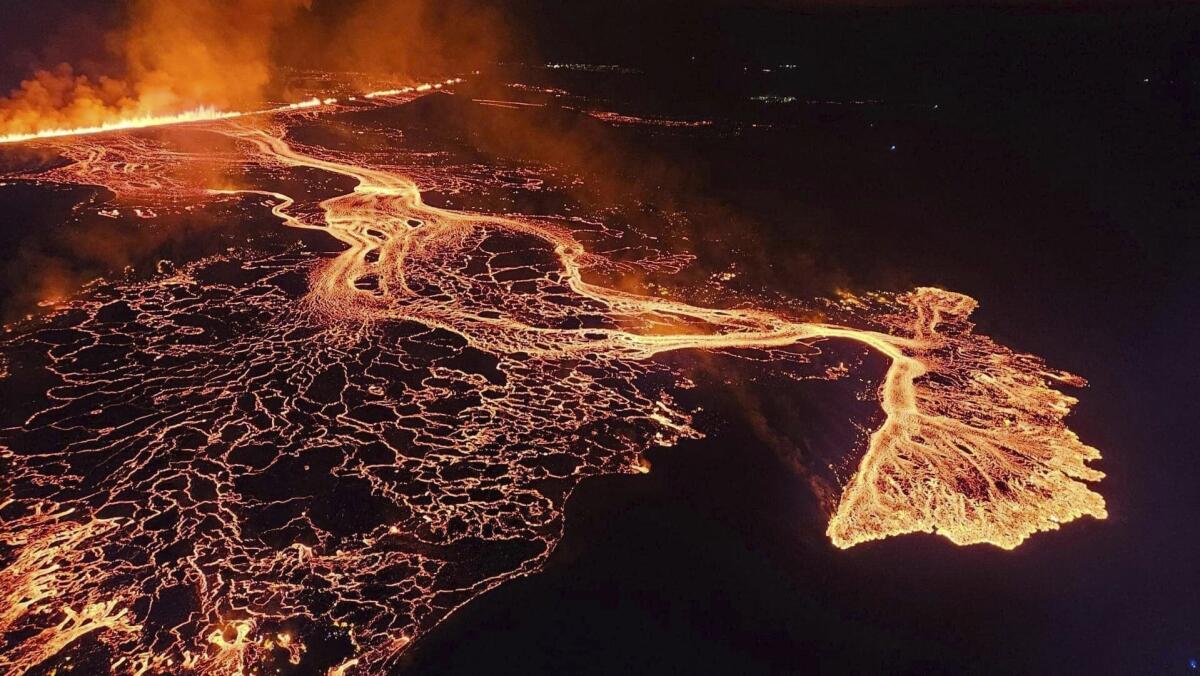Iceland volcano erupts again but spares nearby town for now

- Share via
GRINDAVIK, Iceland — A volcano in southwestern Iceland erupted Thursday evening for the sixth time since December, spewing red lava through a new fissure on the Reykjanes Peninsula.
The eruption began shortly after 9 p.m. following a series of strong earthquakes, and within the hour a 2½-mile fissure cut through the Sundhnukur crater.
Iceland authorities say the eruption’s effects remain localized with road closures but do not threaten the population.
Halldor Bjornsson, head of weather and climate at the Norwegian Meteorological Agency, told the Icelandic news portal Visir that, unlike previous eruptions, the lava flow is not heading for the town of Grindavik, which was largely evacuated in December when the volcano came to life after being dormant for 800 years.
Magnus Tuma Gudmundsson, a geophysicist who flew over the eruption Thursday evening, told the website that “if this continues like this, Grindavik is not in danger because of this. Of course, we don’t know what will happen in the near future, but it is likely that this has reached its peak and then it will start to subside like the other eruptions.”
As news of the eruption spread, hundreds of curious onlookers drove to nearby vantage points for a view of the stunning natural phenomenon that has become a key tourism attraction.
“We just thought that it was the Northern Lights,” said Mahnoor Ali, visiting from Maryland. “It’s like the coolest thing I’ve seen in my whole life, honestly.”
Friends Ameerul Awalludin from Malaysia and Shohei Miyamito from Japan were with an Icelandic friend when they heard the news and rushed to be closer to the eruption.
“We have like a volcano as well,” Miyamito said, referring to his homeland, but “we cannot see lava like this.”
For people living and working on the Reykjanes Peninsula, the regular eruptions and ensuing evacuation orders will undoubtedly be met with frustration.
The repeated volcanic eruptions close to Grindavik, a town of 3,800 people about 30 miles southwest of the capital, Reykjavik, have damaged infrastructure and property and forced many residents to relocate to guarantee their safety.
The few who had returned were forced out once again Thursday night as strong winds blew plumes of toxic gas over the town.
The nearby Blue Lagoon geothermal spa — one of Iceland’s biggest tourist attractions — was also evacuated, with social media videos showing sirens blasting around dusk.
Iceland, which sits above a volcanic hot spot in the North Atlantic, averages one eruption every four to five years. The most disruptive in recent times was the 2010 eruption of the Eyjafjallajokull volcano, which spewed clouds of ash into the atmosphere and disrupted transatlantic air travel for months.
This eruption is not expected to affect air travel.
Di Marco and Keyton write for the Associated Press and reported from Grindavik and Berlin, respectively.
More to Read
Sign up for Essential California
The most important California stories and recommendations in your inbox every morning.
You may occasionally receive promotional content from the Los Angeles Times.










